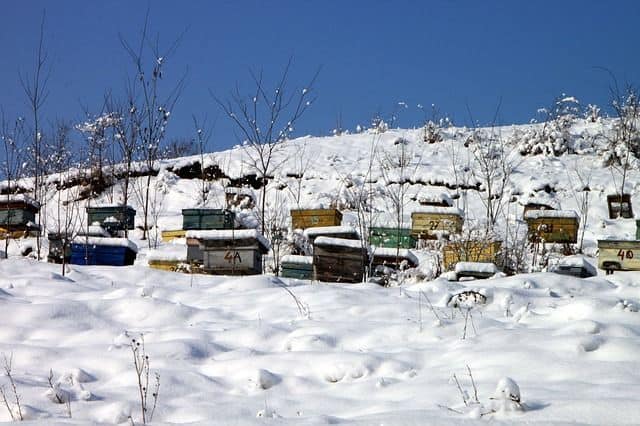Last Updated: 16 April 2025
Making honey is a natural process so it isn’t surprising that it is guided by the change of the seasons. Whether you practice beekeeping as a business or a hobby, there are certainly lots of factors that you need to take into account. Beekeeping in winter is one of these factors.
During the winter months, the honey bee workers keep the queen and brood warm by creating a cluster around them. The bees inside the cluster feed on the honey, while the outer bees (the workers) help insulate their sisters inside.
Bees consume about 50 to 60 pounds of honey during winter time. That’s all they eat within the cluster and will break the cluster to a new area so they can get more honey.
It’s a harsh system for the bees outside the cluster, but it is essential to keep the hive alive. The temperature outside may be freezing, within the cluster, it will stay consistently at about 92 degrees F.
Ok, so we’re firstly going to assume that you have a beehive, if you have not, take a look at our recommended beehives for sale or beekeeping starter kits.
Table of Contents
How to Keep Your Beehive in Winter
Beekeeping in winter actually starts way before winter. As we all know, winter is a critical time for our bees. Making sure that they are strong enough and well prepared to survive the cold takes skill and great care.
For example, during the winter, you need to check your hive to make sure that there are not too many holes or repairs needed. So you’ll need to pre-clean, repair, and store all the essential tools that you’ll need for the winter.
You should also expect some of your bees to leave the colony and die. So be prepared to order more bees if necessary as well as any beekeeping equipment you need from a reputable supplier. There are a lot of things that you should put into place before winter arrives.
During the winter months, get involved in a bee-related hobby such as brewing some mead, making beeswax candles, and visualize spring!
In many ways, beekeeping in winter is all about sitting back and enjoying the fruits of your hard work. Or, to look at it from another angle, it may be a time for regret as you realize that you’ve not prepared as much as you should have.
To make sure it is the former for you, and not the latter, here are 12 beekeeping winter tips to help guarantee your hive’s survival.
1. Assess every beehive to ascertain its weight
You should know what each of your hives weight. This will give you an idea of how heavy they will be by the end of winter. The minimum weight should be about 70 lbs (32 kilograms).
Why is this necessary? Well, this will give you a general idea of how well the hive is thriving because anything below this weight may mean that the hive needs help.
Take all precautionary steps before winter in preparation. If you find that some of your hives weigh less than 70 lbs, you should make those hives a priority and provide them with more food – before and after.
2. Store your beekeeping tools and equipment correctly
Before winter starts (and during the cold months), make sure you are prepared for any emergency. Clean your beekeeping equipment and ensure that they are clean and ready for any cleanup emergency.
For example, you must ensure that all wooden tools are totally free of propolis and wax. A handy way to do this is to create a mixture of water and soda, then use this mixture to properly remove wax and other unwanted materials from the surface of the equipment.
Also, you should make sure that your brood combs are sterilized; especially the old ones. Take the frames and boxes out and keep them in a secure place for about 5-7 days so that they can air out before you use them again. Do this before the winter season as part of your preparation tasks.
These steps and many more will help you get rid of any existing pests.
3. Join a beekeeping club near you
Aside from this website, you need to stay in touch with other beekeepers near where you live. You don’t have to be a social butterfly (it’ll help a lot if you make it social and fun), but just knowing what the current trends are and what to expect every season will go a long way in keeping your prepared.
Beekeeping clubs are a lifesaver for a beginner, especially for a hobbyist who want help with beekeeping in the winter.
Join in on the learning and hands-on training events as they become available. When you associate with other beekeepers who share your love and passion for beekeeping, you will be motivated while also learning some new tips that will inspire you to take your beekeeping to the next level. Best of all, you get a chance to share what you’ve learned and help other newbies out!
4. Make sure you have a large number of bees in your hive
Often and especially in early spring, beekeepers are so concerned about preventing swarms that they intentionally control the size of the hive so it doesn’t become too big. In winter, the larger the colony, the greater the chances of survival.
Don’t be afraid to have a large number of bees in your hive. The more there are, the more protection they will receive during the cold winter months.
5. Make sure your hive is well stocked with honey
Again, in response to swarm management, some beekeepers intentionally keep the honey stores low. Or it is also possible that after honey is harvested, a little is left behind for the colony. It is important to have the honey stores healthy if you want your bees to have enough food throughout winter.
6. Stock up on pollen and time it correctly
Aside from honey, your bees will also need pollen. Pollen provides bees with protein which they will need in order to survive the winter.
Broods are reliant on pollen, some experts prefer to withhold pollen just to keep the population small right before winter so as to conserve food stores.
Keeping a sizable brood nest may not be the best thing for your hive during the winter months so you have to time this correctly because stimulating brood production too early may be unwise.
7. Make sure you have a strong queen
A strong queen that lays a solid sealed brood right from the start is necessary. This makes a big difference in the strength of your hive. The more brood that can be produced, the greater the numbers of bees in the colony, the more foragers it can send out to gather and produce the food that it needs.
The more bees you have in your colony, the better it can prepare for winter, and the better it can insulate itself against the cold.
8. Prevent your bees going into swarm mode
When bees prepare to cast off a swarm, production of new brood is halted, and resources are taken away from food collection to prepare for the expansion.
9. Monitor your brood nest
Bees are prone to building a honey dome above them and this can become a barrier and limit the space that your queen bee has to work with. You need to monitor it and add an empty drawn comb to give your bees more room for brood expansion.
10. Frequently check on your bees
Monitor the entrance to the hive and remove any dead bees or ice that could be blocking the entryway.
When winter is particularly harsh, one of the things you need to watch out for is moisture accumulating inside your hive box. Moisture happens because the temperature outside is far lower than the temperature inside the box.
Cold moisture dripping on the bees will hurt them because they can’t effectively stay warm with cold water dripping on them. One way to prevent this is by insulating only the top of your hive box just before winter.
11. Ensure that the hive is protected from the wind
As winter gets more intense, frequently monitor the colony for wind damage, and make sure that there is ample ventilation. Your bees can take the cold, so you shouldn’t seal the hives completely because heat and lack of air can totally destroy the population.
12. Make sure all disease treatments are complete
Right before winter is the best time to ensure that all disease treatments are complete. Think of ways to keep your hives healthy and prepared for any diseases or pests that may come with the change of weather. Of cause, you must make sure that this is the case all year round, but winter is one time of the year that beekeepers neglect this part of their duties.
It is also time to keep the colony safe from bigger predators like humans, foxes, wasps, and badgers. Create protective structures to keeps animals out of the colony and signs to keep humans away.
Conclusion
The above 12 tips will get you through the winter months and keep your hive healthy and thrive for another season.
Remember, your hive’s ability to survive the winter will depend on their food stores. They need more energy to keep warm and this energy will come from the stored honey. You must ensure that the hive does not run out of honey or the bees will freeze to death before spring.
For more information on how to look after your bees during the winter, check out our article on how to winterize a beehive.

